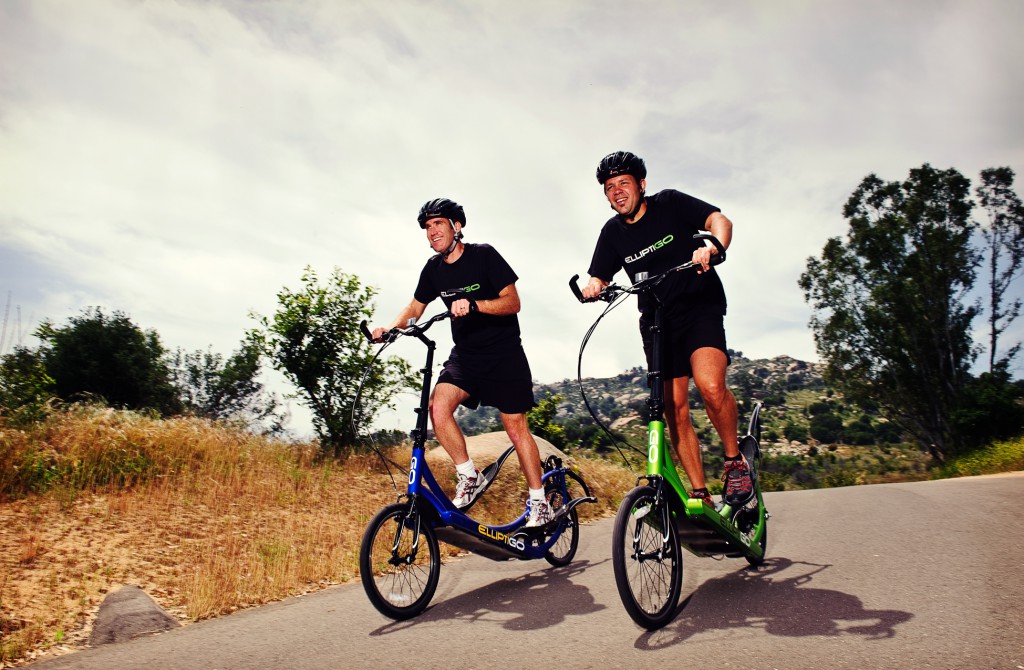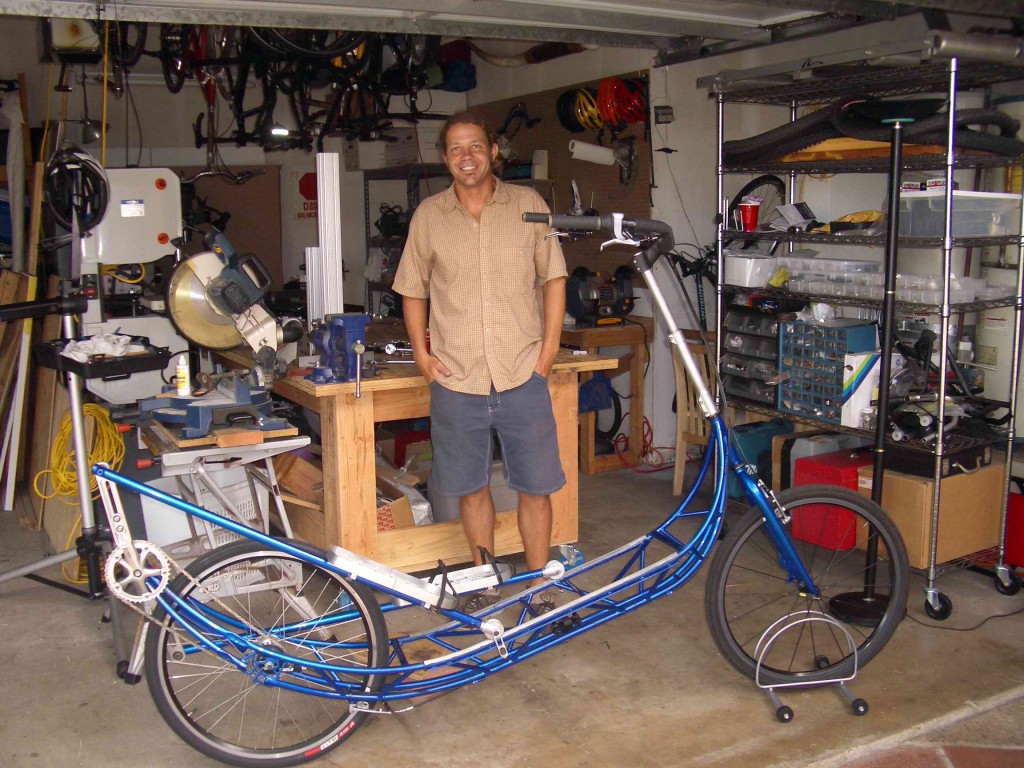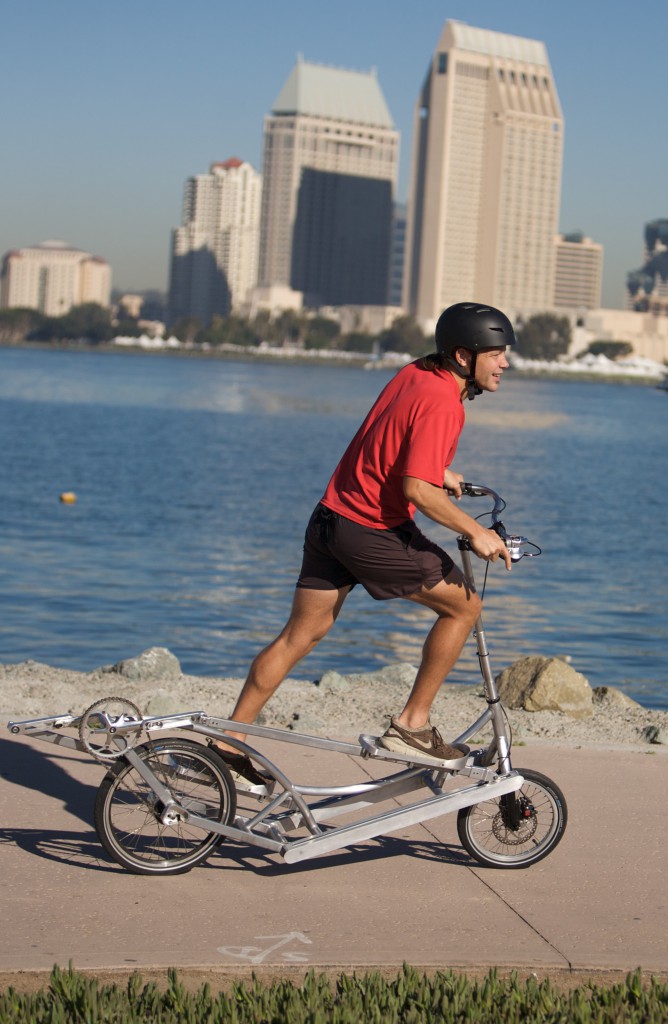 Necessity, Ingenuity, and a Patent License: The Story of ElliptiGO
Necessity, Ingenuity, and a Patent License: The Story of ElliptiGO
At around the age of 30, San Diego native Bryan Pate, co-founder of ElliptiGO, found his body suddenly rebelling against nearly three decades of competitive sports and participation in endurance races such as Ironman and other triathlons (not to mention a stint with the U.S. Marine Corps, during which he led a sniper platoon in the Persian Gulf). “I found myself at the point where I really couldn’t run for exercise without being in a lot of pain while running, as well as in the days after,” says Mr. Pate. “Eventually, the pounding on my knees and hips got to the point where I just couldn’t sustain it as a fitness activity.” Resigned to his fate, but dissatisfied with outdoor alternatives to running, such as swimming and cycling, Mr. Pate began using elliptical trainer machines at the gym, which offer a low-impact alternative to the treadmill. But again, he was left wanting. “I really didn’t like the gym experience; I didn’t like driving to a gym, waiting for machines, not getting the right machines—it really just started to feel like I was exercising for the sake of exercising.”
Then, while using an indoor elliptical machine one day, the idea hit him. “There must be some company that sells an outdoor elliptical bicycle-type device, and I should just go buy one,” he thought. “So I went home and did a search on GOOGLE and tried to buy one and it didn’t exist, which was very frustrating.” That frustration set Mr. Pate—a lawyer by training and former marketing manager—on a unique and, ultimately, fortuitous path. In partnership with his friend and former coworker at Palomar Technologies, mechanical engineer Brent Teal, Mr. Pate began working on the world’s first “elliptical bicycle,” which they called the ElliptiGO. Propelled by the same motion as an indoor elliptical machine, the ElliptiGO allows for a high-endurance, outdoor experience, without the typical wear and tear caused by running. The device is particularly well-suited for climbing competitions, and ElliptiGO Inc. has hosted its own races, including the Elliptical Cycling World Championships, since 2010.
While the road to getting the bike to market and starting a company was full of challenges—including the discovery of an existing patent on the core technology for an outdoor elliptical bike—Mr. Pate’s passion to compete outdoors again ultimately combined with determination and innovation to address a void that he and his business partner have now filled for thousands of customers.

Describe the ElliptiGO—how is it different from a traditional bicycle?
It’s technically not a bicycle; it’s an “other cycle,” because it doesn’t have a seat. However, just like a traditional bicycle it is classified as a vehicle under the vehicle codes in every state. It works, in short, by taking strides like one does on an elliptical trainer, using that horizontal elliptical path, which turns a crank that is then attached by a chain to the rear wheels just like a bike. Just imagine that the rear wheel of an indoor elliptical trainer was an actual tire, and then that there were handle bars and a front wheel attached at the front end.
The reality is that, if it were not for the patent system, the rate of innovation would drop precipitously.
Performance-wise you can do easily 20 miles per hour on flat ground, 25 mph in a sprint. It can go anywhere a road bike can go. The best thing it does is climb. It has climbed up every major climb in the cycling world: Pike’s Peak in Colorado, Mount Washington, the Haleakala volcano in Hawaii, Alpe d’Huez and Mount Ventoux in France. The ElliptiGO has even done some of the toughest cycling events in the world, including the Paris-Brest-Paris, London-Edinburgh-London, the California Death Ride, and the Triple Bypass. There’s really no challenging cycling event left that hasn’t been completed by an ElliptiGO rider.
The ElliptiGO has been given its own category at a handful of running events as well, and we also create our own events. We’ll have our seventh World Championship this year, which consists of a climb up Palomar Mountain, featuring 4,200 feet of vertical gain over 11.7 miles. From an exertion standpoint, it’s very similar to running a half marathon. We’ve had Olympians compete in our races, including Mary Decker Slaney, one of the most successful American runners in history.
But it’s easier on your body than running?
It’s amazing. Take someone like John Mistler, a former NFL football player who has had dozens of knee surgeries and often finds it painful to walk. He bought an ElliptiGO a few years ago and has had zero pain when riding. He is such an enthusiast now that last year he rode his ElliptiGO from San Francisco to Los Angeles along Pacific Coast Highway. That is a 500-mile journey. The mechanism is extremely gentle on your body, particularly your knees. Although we have many customers who are still active runners, even the ones who can’t run and the ones who can barely walk for exercise are able to ride the ElliptiGO pain free and challenge themselves to 100-mile rides.
Once you came up with the idea for the ElliptiGO, how did you begin your journey toward creating it?
We weren’t willing to invest a lot of time, energy, and money into it if we thought at the end of the day that someone else had already beaten us to it.
I spent about a month researching whether there was something like it already out there. One of the first places I went was to the U.S. Patent and Trademark Office [USPTO] website. I had never done much patent searching up until then, but I’m an attorney by training, so I had some willingness to leap into that without too much fear or concern. I didn’t find anything that looked particularly concerning, so I called up a friend of mine, Brent Teal, who is a mechanical engineer and a fellow Ironman triathlete and runner. We had worked together developing new products, and I knew he was a very capable endurance athlete so I was sure he would understand the need for the product and also what it would require performance-wise. So I asked him if he could design and build one and he said, “I can, but I’m sure something like this must already exist.” So we continued our pursuit of the IP landscape; we understood that if somebody had already bought the IP or was in the process of releasing a product, we weren’t particularly well-positioned to develop it. We weren’t willing to invest a lot of time, energy, and money into it if we thought at the end of the day that someone else had already beaten us to it.

We found a handful of patents in the space, but they weren’t well-written and didn’t conceive of what we wanted to make. So in August 2005, Brent actually started designing a prototype. We both had full time jobs so it took about a year to get the prototype built. My maiden voyage was June of 2006. We expected that it would be impossible to ride and that would show us why the product didn’t exist. Instead, we found out that it was actually pretty fun and easy to ride. The first time I got on it, I did 20 miles on it. I rode the bike for over an hour, hit 20 mph at top speed and people were pulling up next to me rolling down their windows, hooting and hollering. This first prototype was named Alfa and it was very much a proof-of-concept cobbled together from off-the-shelf steel tubing and parts we took from our own bikes or found on eBay. It was a real sight to behold. But it worked.
But you eventually discovered that someone did already have a patent, correct?
Yes. I rode the prototype for about six months, and then Brent started building his third design, after quickly coming up with a better idea than his second design. By Christmas of 2006, he was already starting to finalize the design for the third generation, which is when I came across Larry Miller’s patent.
Larry Miller was the inventor of the indoor elliptical trainer. He had 16 patents, 10 of them on the indoor elliptical, all licensed to major fitness equipment manufacturer, Precor. The first two patents were the subject of enforcement actions against about a dozen different players in the indoor elliptical space that went through five years of litigation in the 1990s. The result was that, after a reexamination that came back very clean, all the defendants settled in the favor of Precor. On September 12, 2001, Miller filed a provisional patent on the outdoor elliptical bike. By the time we discovered it in 2007, it was a granted patent that was good until September 11, 2021. We had filed our own provisional patent in September of 2006, and fortunately we had developed a lot of innovations that Miller had not thought of that we believe are important for making a commercial elliptical bike.
How did finding that patent change things for you?
When we first found Miller’s patent, we were crushed. We actually quit the project for about a month. Brent and I were very focused on IP, because we realized that if we were successful and created something that was a viable product for the world, we would get quickly overrun by the 100+ existing bike and fitness manufacturers that were so much better positioned than we were to manufacture and distribute a product like this. We had a pretty solid belief in the effectiveness of the patent system and that belief is what allowed us to move forward into this space. We both had good jobs, so we weren’t looking for something to do. The bottom line is that there’s just way too much risk in trying to start a company that makes a physical product if you can’t protect your innovation and prohibit someone else from copying you.
So when we came across Miller’s patent, I spent about a week really reading it, thinking about it, and on the phone with Brent trying to decide if we could design around it. We couldn’t figure out how to do that, so we stopped working on the ElliptiGO. About a month went by before I gave Brent a call to see how he was feeling about re-starting the project. Brent had just quit his job to work on the ElliptiGO project full-time and I knew he wanted to build the next generation. So I told him I’d continue to pay for everything and we agreed we would chug forward and see how it goes.
Then, we noticed that Miller missed his payment for his maintenance fees in June 2007, and he had six months to make the payment before his patent would be abandoned. We had no idea if his concept was already in production, or had been totally forgotten about. Rather than keep waiting to see how things played out, we decided to call Miller up. We tracked down his phone number, called him and said “We want to talk to you about your elliptical bike patent.” And he said, “Oh, I love that thing, let’s talk about that.” We got into the discussion about how we had started working on something similar and wanted to get an exclusive license to his patent. He laid out a potential license structure, and within 20 minutes we had the material terms of the deal basically agreed to. It was very nerve wracking, but within those 20 minutes the whole world turned 180 degrees for us.
Is it an exclusive license?
Yes, it’s an exclusive license and we have the right to sublicense. Since then we have had 23 additional patents issued to us, so we’ve accumulated quite a bit of intellectual property. Miller’s patent covers the foundational concept of using the elliptical motion to propel a vehicle, and our patents cover elements of the product that we think are required to make it commercially viable. We have patents in China, the UK, Germany, France, Australia, and Canada.
Why didn’t you wait to see if the patent would be abandoned?
It becomes an interesting situation, because you can revive an abandoned patent if you show that it was not abandoned due to your negligence. Basically though, we were done living in limbo. It was an emotional thing. We decided that we were either going to get a license to this patent, or we were done. We called it “our come to Jesus meeting.”
There are people who would say it isn’t fair that you had to take a license, since Mr. Miller wasn’t even using the patent. How did you feel about it?
People who are critical of the patent system probably don’t understand the nuances of the problem with incentivizing innovation.
I think it’s a very complicated issue. People who are critical of the patent system probably don’t understand the nuances of the problem with incentivizing innovation. People go into it with an assumption that these innovations would happen anyway, even if there wasn’t a patent system, so therefore they think we’re really not incentivizing anything, just grossly over rewarding the person who thinks of something, as opposed to the person who actually makes it a viable product. I think there are some elements of that argument that are valid in the sense that the monopoly element of the patent can result in a disproportionate windfall to the inventor at the expense of the manufacturer; however the reality is that, if it were not for the patent system, the rate of innovation would drop precipitously. That’s because many inventors are unwilling to take the risk to bring an innovation to market if they don’t see a path to a payout that justifies that risk. So I think weakening patent enforcement provisions is short-sighted and there’s an element of entitlement behind that argument. Basically, I perceive those people as feeling entitled to the inventions of others. They expect to benefit from innovative developments like the ElliptiGO, but they’re not going to, because the majority of entrepreneurs are people who could be doing other things with their time. Like everyone, innovators like me and Brent are going to optimize for ourselves, not the common good. If we don’t see a path to benefitting personally from bringing an innovation to market, then we’re not going to do it. Instead, we’re going to take the safer route and work at established companies, and the pace of innovation is simply going to slow down.
Was finding the patent the biggest challenge you faced during the process?
No. There are a lot of challenges that come with getting a company off the ground. Number one is getting a product that really works well. Without that, you don’t have anything. Number two is raising money, getting a team together and figuring out how to get the product produced and distributed. Number three is being lucky enough not to get derailed by the thousands of things that are out of your control. Securing the patent was one of the critical steps in making the company viable, but it wasn’t our biggest challenge.
Would you go down the path of inventing again? Do you have other ideas?
Yes—too many. The world is unfortunately fraught with opportunity for improvement, and I think that innovation is a crucial practice for Americans in particular. It’s what our economy is becoming more and more built upon, so I think it’s important for us to innovate as a society. Now that I have some experience with the process, it’s much less intimidating in some regards and much more intimidating in others, but I have ideas almost every week.
What would your advice be to other inventors and entrepreneurs given your experience?
First—it’s hard. One of the most helpful phrases I learned in the Marines is that “Easy things are hard and hard things are impossible.” It’s true – nothing is easy when it comes to bringing a new concept to market. At the same time, it’s way better to put your energy into something you’re really passionate about rather than showing up at work every day to spend time dedicated to something you don’t care about. If you’re so inclined to go down a path like this, where you’re trying to build a successful business around something innovative that has never been done before, number one, you should be very, very personally committed to the item you’re trying to bring into the world, and very compelled to bring it into the world for more reasons than just to get rich. Getting rich should be one of the least motivating factors. I think you need to look at it almost like a cause rather than a business opportunity. If you’re really trying to do something revolutionary, it’s going to take a very long time for it to be successful and it might not be successful, so all you’ll be left with is the question of whether you did something good for the world, and did you get the psychological benefits of helping other people? The days that stuff goes wrong are going to be even harder if you can’t see the palpable benefits you’re delivering to individuals you care about. If you know that people are better off if you sell just one of these things, that in and of itself can be a success, and can get you through the hard parts of getting something off the ground.









